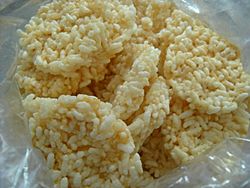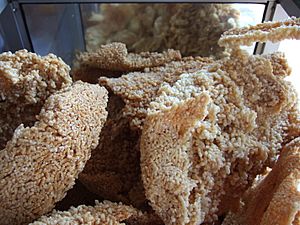Rengginang facts for kids

Rengginang
|
|
| Alternative names | Ranginang, intip (Javanese) |
|---|---|
| Type | Rice cracker |
| Course | Snack |
| Place of origin | Indonesia |
| Region or state | West Java, Banten |
| Created by | Sundanese cuisine |
| Serving temperature | Room temperature |
| Main ingredients | Rice |
Rengginang (also called ranginang) is a yummy, thick rice cracker from Indonesia. It's made from special cooked sticky rice. First, the rice is seasoned with spices. Then, it's shaped into flat, round pieces and dried in the sun. After drying, these rice crackers are deep fried in lots of cooking oil. This makes them super crispy and delicious!
Rengginang is different from other traditional Asian crackers like Indonesian krupuk or Japanese senbei. Most crackers are made by grinding ingredients into a smooth paste. But rengginang keeps the shape of its rice grains. It's a bit like Japanese arare, but arare are separate rice pieces. Rengginang rice grains stick together in a flat, round shape. Sometimes, rengginang is even made from dried leftover rice. In Suriname, people call it brong-brong.
Flavors of Rengginang
You can find rengginang in many flavors. Some are plain, while others are sweet, salty, or savory. The most common type is salty. It's deep fried with a pinch of salt for that classic taste.
Sweet rengginang is coated with thick, liquid coconut sugar. Other kinds of rengginang have extra ingredients for more flavor. These can include dried prawn, terasi (shrimp paste), or lorjuk (razor clam).
What is Intip?
In Central Java, especially in a place called Wonogiri Regency, there's a very similar rice cracker. It's called intip. This cracker is made from scorched rice. Scorched rice is the hard, slightly burnt rice that sticks to the bottom of a pot after cooking.
To make intip, water is added to the cooking pot to loosen the stuck rice. Once separated, this sticky rice is sun-dried until all the water is gone. Then, the dried sticky rice is deep fried in a lot of oil. This turns it into a crispy cracker.
There isn't a big difference between rengginang and intip, except for their size. Because intip comes from the bottom of a cooking pot, it's usually much larger than rengginang.


